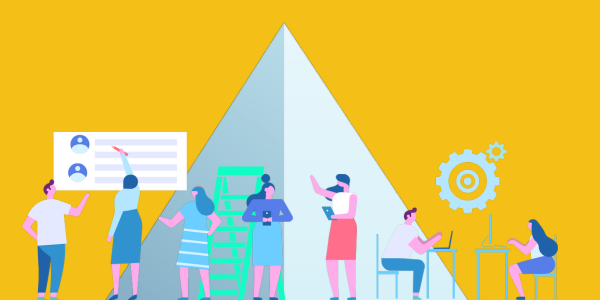Team Buy-in, Transparency, and Other Lessons Learned from DES’s Agile Transformation

What’s the best way to improve the quality of your work while meeting the ever-changing needs of customers and stakeholders? The Division of Enterprise Services (DES) answered that question by adopting an Agile framework to manage the agency’s two enterprise systems, SharePoint and Salesforce Enterprise Integration.
The DES team is made up of IT specialists, technical advisors, and directors. Because OIT has built an in-house infrastructure for supporting professional development, they didn’t have to look far to start their Agile education.
To begin their Agile transformation, all 10 DES team members took courses in the Workforce Resilience Program (WR) which provided the knowledge and skills to adopt Agile practices while working toward the division’s goals to:
- Gain the ability to pivot at any time to meet shifting business needs
- Provide added value to stakeholders and customers
- Learn how to better support customer service requests and product upgrades
Completing the training was a significant investment for DES. Starting in September 2022, the entire division participated in the program over the course of nine weeks.
Product owner and product management teams enrolled in the Product Management: Awareness pillar and the Product Management: Competency Level 1 pillar. After completing the Product Management track, DES directors continued on to the Leadership track, completing both the Awareness and Competency pillars. The Awareness pillar, which was a lighter lift for the team, lasted three weeks. DES found additional value by digging deeper into the Competency pillar. This track was a larger investment, requiring two hours of training over the course of six weeks, but it enabled them to transition more easily into the role of Product Management.
Practice Makes Perfect
As part of the training, DES staff met weekly with CMS Agile coaches Jason Corning of OIT’s Division of Technical Engineering and Architecture, Dean Chanter (Okto Consulting), and Roy Marrerro (formerly Octo Consulting) to discuss how the curriculum related to their daily work. This hands-on approach meant DES could apply what they learned to real-world projects instead of hypothetical situations. For example, the team learned how SAFe Framework (Scaled Agile Framework) principles could help them meet customer requirements.
“The coaches helped guide our division to transition development, security, and operations into a fully Agile state,” says DES Director Shauntia Bell. “Prior to their involvement, both systems were being developed using mainly waterfall methodologies, outside of Jira. The coaches enabled DES to transition to CMS Agile tools, such as Confluence, Jira and EaziBI, and aided in creating metrics and measurable outcomes.”
Outcomes and Four Lessons Learned from DES’s Agile Transformation
“The overall value and return on investment are already evident based on increased capacity, velocity and quality across applications,” says DES Deputy Director Kelly Gelletly.
The division has reduced time to project implementation and completion, which has “improved the business community’s view and trust in OIT to deliver and provide quality products,” says DES ISSO Peter Koza.
Key factors that played a role in these outcomes were team engagement, better-defined roles and responsibilities, improved communication for more accountability, and simplified processes to increase transparency. Here are four lessons DES learned throughout the training and transition:
Lesson 1: Team buy-in advances learning and engagement.
Many efforts to change business practices go nowhere fast without team buy-in. The WR training helped achieve this goal by bringing DES together. By applying course materials to the division’s own projects, team members learned they could have a stake in the outcome of the training. They could apply their knowledge to scenarios unique to DES and see a direct impact on their work.
“Commonly, when individuals take courses alone, it can be difficult to imagine how to incorporate new methods into your team’s day-to-day work,” Bell says. “However, when these courses are taken as a group, you’re able to brainstorm with your teammates to apply these new methods almost immediately. Everyone in DES was able to move in the same direction, at the same speed, with little hesitation.”
Lesson 2: Defined roles and responsibilities boost productivity.
Before WR, team roles were loosely defined. Team members might drift into each other’s lanes, creating more work and frustration. DES learned that their team’s structure impacts how effectively and efficiently they perform tasks.
Agile coaches encouraged the team to take a step back and thoroughly define roles and responsibilities. By determining these expectations, DES has improved team coordination, made priorities more visible, and increased staff autonomy.
Lesson 3: Cross-team communication fosters awareness and accountability.
Taking time to plan projects and follow up using Agile processes promotes cross-team communication, helping everyone understand priorities and timeframes. DES learned that communicating with business users early and often helps the team gather more information for projects and develop a better understanding of business requirements.
“Adherence to regular scrums and strategy sessions facilitates communications and promotes accountability” states Craig Brewer, DES Technical Advisor.
The sessions enable the division to show earlier iterations of their work, an added value for stakeholders.
Lesson 4: Simplicity promotes transparency.
DES learned the importance of breaking down projects into smaller tasks. Using Agile practices, the team divides project requests into smaller User Stories, reducing the complexity of tasks. This helps the team understand project requirements and allows visibility into each stage of work. Using tools such as JIRA, the team can increase transparency with stakeholders.
“All of our SharePoint work is in Jira and all of the agencies have access to see our product work,” states the SharePoint Team. With this kind of transparency, they can better identify blockers early on and provide more timely solutions to customers.
To learn more about transformative learning opportunities for you and your colleagues, visit the WR Confluence site.

